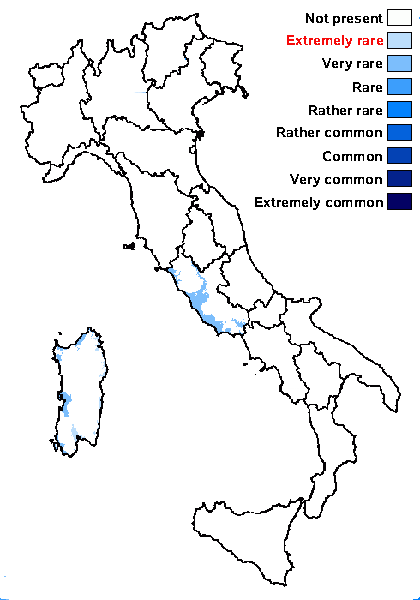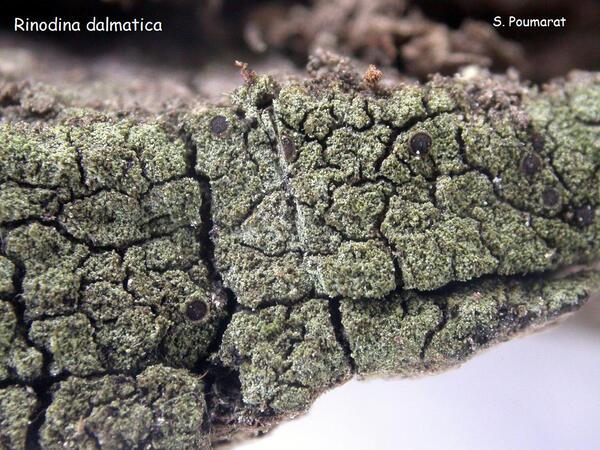Rinodina dalmatica Zahlbr.
Österr. bot. Z., 51: 348, 1901.
Synonyms: Lecanora dalmatica (Zahlbr.) Croz.
Distribution: C - Laz (Giralt & al. 1994, 1995), Sar (Zedda 2002).
Description: Thallus crustose, areolate, ochraceous to pale brown, finally entirely covered with yellowish brown, dark grey-green, olivaceous to brown, up to 25-30 μm wide blastidia. Apothecia frequent, at first lecanorine, but soon becoming biatorine, 0.3-0.5(-0.8) mm across, with a brown to brown-black, concave to finally convex disc, the young ones with a thin, entire thalline margin which disappears in older apothecia. Thalline exciple ecorticate, 50-70 μm wide laterally, filled with small crystals reacting P+ orange-red; proper exciple indistinct laterally, to 20 μm thick in upper part; epithecium orange-brown, with a granular epipsamma reacting P+ orange-red; hymenium colourless, 100-120 μm high; paraphyses 1.5-2 μm thick at mid-level, the apical cells 3-5 μm wide; hypothecium yellowish, 50-80(-100) μm high. Asci 8-spored, clavate, the K/I+ blue tholus penetrated by a faintly amyloid apical cushion with parallel or diverging flanks, the wall K/I-, surrounded by a K/I+ blue outer layer, Lecanora-type. Ascospores 1-septate, constricted at septum, brown, ellipsoid, (17-)20–23(-26) x (8-)10-12(-13) μm, Pachysporaria-type, smooth, with a well developed torus, the young ones with polygonal lumina and a type A ontogeny (apical wall thickening after the early septum formation). Photobiont chlorococcoid. Spot tests: thallus K- or K+ pale yellow, C-, KC-, P+ red, UV+ orange. Chemistry: thallus and apothecia with pannarin and an unknown pigment (traces). Note: a Mediterranean species of acid bark (often on Pinus halepensis, covering wide areas, especially at the base of the trunks) in coastal situations, probably more widespread in Tyrrhenian Italy. It is included in the Italian red list of epiphytic lichens as “Endangered” (Nascimbene & al. 2013c).
Growth form: Crustose
Substrata: bark
Photobiont: green algae other than Trentepohlia
Reproductive strategy: mainly asexual, by soredia, or soredia-like structures (e.g. blastidia)
Commonnes-rarity: (info)
Alpine belt: absent
Subalpine belt: absent
Oromediterranean belt: absent
Montane belt: absent
Submediterranean belt: absent
Padanian area: absent
Humid submediterranean belt: absent
Humid mediterranean belt: very rare
Dry mediterranean belt: extremely rare

Predictive model
Growth form: Crustose
Substrata: bark
Photobiont: green algae other than Trentepohlia
Reproductive strategy: mainly asexual, by soredia, or soredia-like structures (e.g. blastidia)
Commonnes-rarity: (info)
Alpine belt: absent
Subalpine belt: absent
Oromediterranean belt: absent
Montane belt: absent
Submediterranean belt: absent
Padanian area: absent
Humid submediterranean belt: absent
Humid mediterranean belt: very rare
Dry mediterranean belt: extremely rare

Predictive model
 Index Fungorum
Index Fungorum
 GBIF
GBIF


